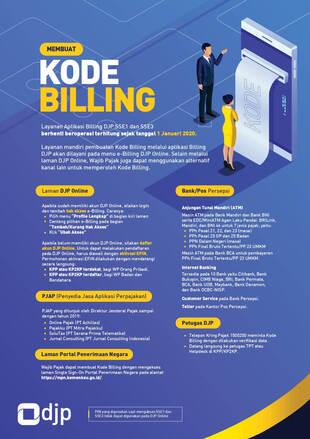QR Code Billing: The Future of Tax Payment

Tax billing codes should be understood by a tax buddy who pays taxes on a regular basis. According to PMK No. 5 of 2014 concerning the Electronic State Revenue System, a billing code is an identification code issued by the billing system for a type of payment or deposit that will be made by the taxpayer, compulsory payer, or required deposit. The current billing code is a combination of numbers.
Taxpayers (WP) can choose various payment methods, ranging from visiting the Perception Bank or Perception Post to paying online through a designated Tax Application Service Provider (PJAP). However, of the various tax payment methods, there is one thing in common: the billing code still has to be input.
Disadvantages of the Billing Code
Creating a billing code is very easy. WP can change their billing code as you wish by using e-Billing. The possibility of human error in inputting is also minimized by DGT with several parameters. For example, when billing for Tax Collection Letters (STP) or Tax Assessment Letters (SKP), if the assessment number or nominal is entered incorrectly and is more than the remaining value of the tax debt, the system will catch it.
However, the DGT billing code still uses a combination of numbers. Coding like this is less efficient. WP still has to input the billing code when paying. This process takes a few seconds. In addition, WP must also recap the billing code when making a lot of billing. In the e-Bupot application, taxpayers can directly make bills such as making proof of deduction (bupot), but for other types of taxes, taxpayers still have to recap the combination of numbers in the billing code one by one.
QR-based Simplification
In the era of increasingly developed digital transactions, there is one method that can be adapted to facilitate payments, namely the use of a Quick Response Code (QR Code). Bank Indonesia (BI) provides QR Codes to standardize QR Code payments.
BI data shows the volume of QRIS transactions was at 54.91 million in February 2022, with the number of merchants providing payment services using QRIS having reached 15.67 million. This large number shows that the public is familiar with the use of QRIS during transactions.
Several local governments (Pemda) have also adapted QRIS as a payment method for regional taxes and levies. Some of them are the Regional Financial and Asset Management Agency (BPKAD) of Jepara Regency and the Regional Revenue and Financial Management Agency (BPKPD) of Sragen Regency.
At DGT, the application of this QR Code can be adapted as an alternative to a combination number billing code. On the bill print, in addition to the combination of numbers, a QR Code can also be included, which contains a similar code. This can speed up the payment process. For example, when paying taxes at the Perception Bank or Perception Post, the teller just scans the QR Code Billing instead of inputting a combination of numbers. As for online payments, taxpayers can directly scan the QR Code when they want to pay taxes. Fast and simple.
Particularly now that DGT has M-Tax, a tax application that offers billing code generation as a service. If QR Code Billing is implemented, it will make it easier for taxpayers, especially MSME taxpayers, to pay their taxes.
This facility is expected to be one way to improve taxpayer compliance. According to Nurhayati Fadjriah Sella and Devy Pusposari's research, tax convenience influences willingness to comply in a favorable way. The results of this study follow the Theory of Reasoned Action, which states that a person will evaluate a perspective or attitude to elicit an intention to perform a behavior. If a taxpayer thinks taxes are easy, they will have a positive attitude, which will make them more likely to follow tax rules (Ajzen, 1991).
A QR Code is not a QRIS
QR Code Implementation Billing is different from QRIS as a payment method. When scanned, it will direct the payer to transfer some money to the recipient's account. This, of course, cannot be implemented in DGT billing because the billing code is not an account. Deposits to the State Treasury use the State Revenue Module (MPN), not direct accounts.
QR Code Billing here only simplifies the combination of numbers in the billing code into the form of a QR Code. The concept is the same as a barcode on a product, which when scanned appears as a unique code. Because of this, the printed bills will still have a set of numbers, but they will also have a QR Code with the same information. Taxpayers can choose which method to pay their taxes.
It needs the readiness of the DGT and tax payment channels such as the Perception Bank and the Perception Post for the implementation of QR Code Billing. However, there is not much that needs to be done. You only need to add an application to read the QR Code Billing into a combination of numbers. Besides QR codes, you can also use barcodes. Further studies are needed to see which method is the most effective to implement.
*)This article is the author's personal opinion and does not reflect the author's agency's position.
- 252 kali dilihat
